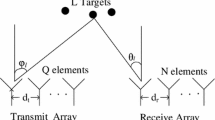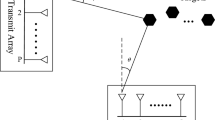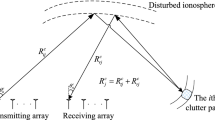Abstract
This paper takes an Alpha-stable distribution as the noise model to solve the parameter estimation problem of bistatic multiple-input multiple-output (MIMO) radar system in the impulsive noise environment. For a moving target, its echo often contains a time-varying Doppler frequency. Furthermore, the echo signal may be corrupted by a non-Gaussian noise. It causes the conventional algorithms and signal models degenerating severely in this case. Thus, this paper proposes a new signal model and a novel method for parameter estimation in bistatic MIMO radar system in the impulsive noise environment. It combines the fractional lower-order statistics (FLOS) and fractional power spectrum density (FPSD), for suppressing the impulse noise and estimating parameters of the target in fractional Fourier transform domain. Firstly, a new signal array model is constructed based on the \(\alpha \)-stable distribution model. Secondly, Doppler parameters are jointly estimated by peak searching of the FLOS–FPSD. Furthermore, two modified algorithms are proposed for the estimation of direction-of-departure and direction-of-arrival (DOA), including the fractional power spectrum density based on MUSIC algorithm (FLOS–FPSD–MUSIC) and the fractional lower-order ambiguity function based on ESPRIT algorithm (FLOS–FPSD–ESPRIT). Simulation results are presented to verity the effectiveness of the proposed method.







Similar content being viewed by others

References
L.B. Almeida, The fractional fourier transform and time–frequency representations. IEEE Trans. Signal Process. 42, 3084–3091 (1994)
T. Alieva, M.J. Bastiaans, L. Stankovic, Signal reconstruction from two close fractional fourier power spectra. IEEE Trans. Signal Process. 51(1), 112–123 (2003)
M.L. Bencheikh, Y.D. Wang, H.Y. He, Polynomial root finding technique for joint DOA DOD estimation in bistatic MIMO radar. Sig. Process. 90(9), 2723–2730 (2010)
M. Bouchard, Improved Noise Power Spectrum density estimation for binaural hearing aids operating in a diffuse noise field environment. IEEE Trans. Audio Speech Lang. Process. 17(4), 521–533 (2009)
S.Y. Chao, B.X. Chen, C.C. Li, Grid cell based detection strategy for MIMO radar with widely separated subarrays. Int. J. Electron. Commun. 66(9), 741–751 (2012)
C. Chen, X.F. Zhang, A low-complexity joint 2D-DOD and 2D-DOA estimation algorithm for MIMO radar with arbitrary arrays. Int. J. Electron. 100(10), 1455–1469 (2013)
C.Y. Chen, P.P. Vaidyanathan, MIMO radar space–time adaptive processing using prolate spheroidal wave functions. IEEE Trans. Signal Process. 56(2), 623–635 (2008)
E. Fishler, A. Haimovich, R. Blum et al., MIMO radar: an idea whose time has come[C]//radar conference. Proc. IEEE. 2004, 71–78 (2004)
S. Gogineni, A. Nehorai, Target estimation using sparse modeling for distributed MIMO radar. IEEE Trans. Signal Process. 59(11), 5315–5325 (2011)
C.C. Li, G.S. Liao, S.Q. Zhu, S.Y. Wu, An ESPRIT-like algorithm for coherent DOA estimation based on data matrix decomposition in MIMO radar. Signal Process. 91(8), 1803–1811 (2011)
J. Li, P. Stoica, On parameter identifiability of MIMO radar. IEEE Signal Process. Lett. 14(12), 968–971 (2007)
J. Li, P. Stocia, MIMO radar with collocated antennas. IEEE Signal Process. Mag. 24(5), 106–114 (2007)
H. Lu, D.Z. Feng, J. He, C. Xiang, A novel method for target localization and doppler frequency estimation in bistatic MIMO radar. J. Electron. Inf. Technol. 32(9), 2167–2171 (2010)
X.Y. Ma, C.L. Nikias, Parameter estimation and blind channel identification in impulsive interference. IEEE Trans. Signal Process. 43(11), 2884–2897 (1995)
X.Y. Ma, C.L. Nikias, Joint estimation of time delay and frequency delay in impulsive noise using fractional lower order statistics. IEEE Trans. Signal Process. 44(11), 2669–2687 (1996)
C.L. Nikias, M. Shao, Signal Processing with Alpha Stable Distributions and Applications (Wiley, New York, 1995)
T.S. Qiu, N. Xia, J.C. Li, S.F. Li, An interference localization algorithm based on Gaussian approximation particle filtering with stable distribution noise. Signal Process. 28(9), 1248–1253 (2012). (In Chinese)
M. Rubsamen, A.B. Gershman, Direction-of-arrival estimation for nonuniform sensor arrays: from manifold separation to fourier domain MUSIC methods. IEEE Trans. Signal Process. 57(2), 588–599 (2009)
H.B. Sun, G.S. Liu, H. Gu et al., Application of the fractional fourier transform to moving target detection in airborne SAR. IEEE Trans. Aerosp. Electron. Syst. 38(4), 1416–1424 (2002)
R. Tao, F. Zhang, Y. Wang, Fractional power spectrum. IEEE Trans. Signal Process. 56(9), 4199–4206 (2008)
P. Tsakalides, C.L. Nikias, Robust space–time adaptive processing (STAP) in non-Gaussian clutter environments. IEE Proc. Radar Sonar Navig. 146(2), 84–93 (1999)
P. Tsakalides, R. Raspanti, C.L. Nikias, Angle/Doppler estimation in heavy-tailed clutter backgrounds. IEEE Trans. Aerospace Electron. Syst. 35(2), 419–436 (1999)
P. Tsakalides, C.L. Nikias, Maximum likelihood localization of sources in noise modeled as a stable process. IEEE Trans. Signal Process. 43(11), 2700–2713 (1995)
J.T. Wang, S.L. Jiang, J. He et al., Subspace-based DOA estimation in impulsive noise environments for MIMO radars. J. Astronaut. 30(4), 1653–1657 (2009)
W. Wang, X.P. Wang, X. Li, H. Song, DOA estimation for monostatic MIMO radar based on unitary root-MUSIC. Int. J. Electron. 100(11), 1499–1509 (2013)
P.R. White, J. Locke, Performance of methods based on the fractional Fourier transform for the detection of linear frequency modulated signals. IET Signal Proc. 6(5), 478–483 (2012)
H.L. Xiao, Q.Y. Shan, Cross-polarization discrimination of MIMO antenna configuration at a mobile station in indoor propagation environment. Int. J. Electron. Commun 64(7), 690–693 (2010)
F. Zhang, R. Tao, Power spectral estimation and its application in fractional Fourier domain. Chin. J. Electron. 36(9), 1723–1727 (2008)
J.Y. Zhang, Z.D. Zheng, X.B. Li, An algorithm for DOD-DOA and Doppler frequency joint estimating of bistatic MIMO radar. J. Electron. Inf. Technol. 32(8), 1843–1848 (2010)
X.F. Zhang, L.Y. Xu, L. Xu, D.Z. Xu, Direction of departure (DOD) and direction of arrival (DOA) estimation in MIMO radar with reduced-dimension MUSIC. IEEE Commun. Lett. 14(12), 1161–1163 (2010)
Acknowledgments
This work was partly supported by the National Science Foundation of China under Grants 61401055, 61139001 and 61172108, and the National Science and Technology Support Program and the Grant 2012BAJ18B06.
Author information
Authors and Affiliations
Corresponding author
Appendix a Derivation of the Expression \(MP_{yz,n}^{\left( p \right) } \)
Appendix a Derivation of the Expression \(MP_{yz,n}^{\left( p \right) } \)
According to (17) and (19), we can define a variable \(z_l \left( t \right) \) as
Supposing the noise \(w_n (t)\) of (14) and (20) is independent and zero-mean Gaussian white noise, the fractional correlation functions \(\hat{{R}}_{yz,qnl}^\rho \left( \tau \right) \) between \(y_{qnl} \left( t \right) \) and \(z_l \left( t \right) \) are defined as
where \(\hat{{R}}_{yw}^\rho \left( \tau \right) \) is treated as a random interference.
The FPSD \(P_{yz,qnl}^\rho \left( m \right) \) between \(y_{qnl} \left( t \right) \) and \(z_l \left( t \right) \) can be expressed as
where \(P_{yw}^\rho \left( m \right) \) denotes the fractional power spectrum of the noise. The \(P_{yz,qnl}^\rho \left( m \right) \) can increase the peak value when both \(\rho \) and m meet the conditions shown in (11), and the position of the peak is also located at \(\left( {\rho _l ,m_l } \right) \). The peak value of \(P_{yz,qnl}^\rho \left( m \right) \) is
According to (17), (35) can be expressed as
When the noise in (14) and (20) are sequences of i.i.d isotropic complex \(S\alpha S\) random variables with \(1<\alpha \le 2\), we can obtain the FLOS–FPSD \(P_{yy,qnl}^{\left( p \right) } \left( {\rho _l ,m_l } \right) \) and \(P_{yz,qnl}^{\left( p \right) } \left( {\rho _l ,m_l } \right) \). According to (36), we have
At \((\rho _l ,m_l )\), the FLOS–FPSD \(MP_{yz,qnl}^{\left( p \right) } \left( {\rho _l ,m_l } \right) \) between (2) and (20) can be expressed as
Because the amplitudes of FLOS–FPSD of different targets are very low at \((\rho _l ,m_l )\), these signals are not considered as random interfering. Therefore, (38) can be rewritten as
Selecting the data of L peak points \(MP_{yz,qnl}^{\left( p \right) } \left( {m_l } \right) \) for \(l=1,\ldots ,L\) as observed data at the receiver, the output of the nth receive antenna in the FRFT domain can be expressed as
The vector of the receiver outputs can be modeled as
where \({\varvec{R}}=\left[ \begin{array}{cccc} {{\varvec{MP}}_{yz,1}^{\left( p \right) } }&{{\varvec{MP}}_{yz,2}^{\left( p \right) } }&{\ldots }&{{\varvec{MP}}_{yz,N}^{\left( p \right) } } \end{array} \right] ^{T}\), \({\varvec{G}}=\hbox {diag} \left\{ {P_{yy,qn1}^{\left( p \right) } \left( {\rho _1 ,m_1 } \right) ,} {\ldots } {,P_{yy,qnL}^{\left( p \right) } \left( {\rho _L ,m_L } \right) } \right\} \), \({\varvec{A}}=\hbox {diag}\left\{ \begin{array}{lll} {A_q \left( {\varphi _1 } \right) ,}&{\ldots }&{,A_q \left( {\varphi _L } \right) } \end{array} \right\} \) and \({\varvec{B}}=\left[ \begin{array}{cccc} {{\varvec{B}}_1 }&{{\varvec{B}}_2 }&{\ldots }&{{\varvec{B}}_L } \end{array} \right] \), where \({\varvec{B}}_l = \left[ \begin{array}{ccc} {{{B}}_1 \left( {\varphi _l } \right) }&{\ldots }&{{{B}}_N \left( {\varphi _l } \right) } \end{array} \right] ^{T}\), \(\left( \right) ^{T}\) and \(\hbox {diag}\left( \bullet \right) \) denote transpose and diagonal matrix, respectively.
Rights and permissions
About this article
Cite this article
Li, L., Qiu, T. & Shi, X. Parameter Estimation Based on Fractional Power Spectrum Density in Bistatic MIMO Radar System Under Impulsive Noise Environment. Circuits Syst Signal Process 35, 3266–3283 (2016). https://doi.org/10.1007/s00034-015-0203-5
Received:
Revised:
Accepted:
Published:
Issue Date:
DOI: https://doi.org/10.1007/s00034-015-0203-5



